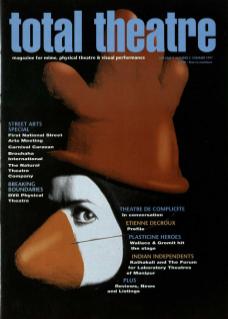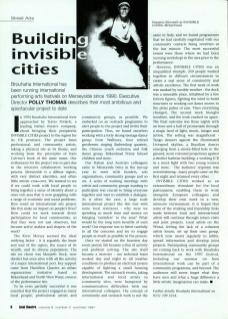In 1994 Brouhaha International were approached by Teatro Potlach, a leading Italian theatre company, about bringing their peripatetic Invisible Cities project to the region for its UK premiere. The project fuses professional and community artists, taking a physical site as its theme, and working from the principles of Italo Calvino's book of the same name. Our enthusiasm for the project was in part due to the intensive collaborative working process. Merseyside is a diffuse region, with very distinct identities, and often little artistic cross-over. We wanted to see if we could work with local people to bring together a sense of identity about a once rich area that is now grappling with a range of economic and social problems. How could an international arts project like this make an impact on people's lives? How could we work towards direct participation for local communities, so that they were not just observers, but became active makers and shapers of the work?
The River Mersey seemed the ideal unifying factor – it is arguably the heart and soul of the region, the source of its wealth, and its diverse population. The site we chose was Morpeth Dock, now derelict but once alive with all the activity of a major international port. Key support came from Hamilton Quarter, an urban regeneration initiative based in Birkenhead and North West Water, owners of the performance site.
To be even partially successful it was essential that the project engaged as many local people, professional artists and community groups, as possible. We embarked on an outreach programme to alert people to the project and invite their participation. Thus, we found ourselves working with a forty-strong teenage dance group from Walleyes, four retired gentlemen singing Barbershop quartets, the Chinese youth orchestra and folk dance group, Birkenhead Priory School children and more.
Our Italian and Austrian colleagues came to Merseyside twice in the run-up year to meet with funders, arts organisations, community groups and so on. A series of working meetings with artists and community groups wanting to participate was crucial to bring everyone together and start to establish a dialogue. As is often the case, a large-scale international project like this met with some local resistance – why were we spending so much time and money on bringing ‘outsiders' to the area? What would be the long-term benefits of such work? Our response was to listen carefully to all the concerns and try to engage people as much as possible in the process.
Once we started on the fourteen day event period, life became a blur of activity and problem solving. The site itself became a monster – our technical team worked day and night in all weather conditions to produce an electrical system capable of lighting a small housing development. The outreach events, taking international and local artists to community sites, were hampered by communication difficulties with our international colleagues. The concept of community and outreach work is not the same in Italy, and we found programmes that we had carefully negotiated with our community contacts being rewritten at the last minute. The most successful events were those where we had been running workshops in the area prior to the performance.
However, Invisible Cities was an unqualified triumph. 250 people worked together in difficult circumstances to create a real sense of community and artistic excellence. The first week of work was marked by terrible weather – the dock was a miserable place, inhabited by a few forlorn figures, fighting the wind to build structures or working out dance moves to the pitter patter of rain. Then everything changed. The second week brought sunshine, and the work cracked on apace. The final outcome was three nights with an hour and a half of promenade through a magic land of light, music, images and action. The setting was magnificent – Tango dancers against the illuminated Liverpool skyline, a Brazilian dancer emerging from a smoke-filled hole in the ground, neon coloured projections against a derelict harbour building, a working JCB in a mock fight with two young women and more. The audience response was overwhelming – many people came on the first night and returned every other.
Invisible Cities worked as an extraordinary stimulant for the local participants, enabling them to work alongside European colleagues and develop their own work in a new, intensive environment. It is hoped that some of the working and friendship links made between local and international artists will continue through return visits and joint projects. Local artists on the Wirral, feeling the lack of a coherent artists forum, set up their own group, which now meets regularly to lobby, spread information and develop joint projects. Participating community groups are coming back to work with Brouhaha International on the 1997 festival, including our seminar on how international work can be part of a community programme, and beyond. The audiences will never forget what they have seen and what a huge difference a little artistic imagination can make.

